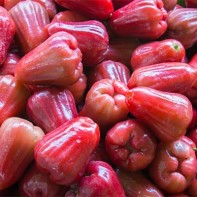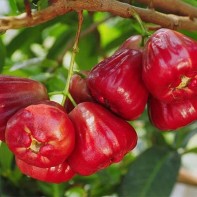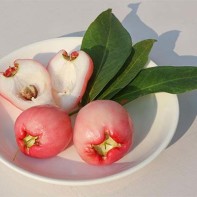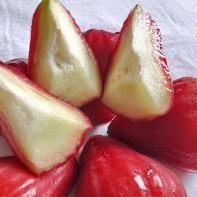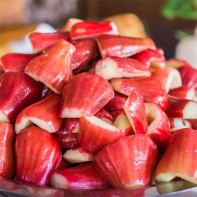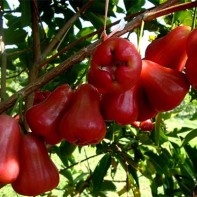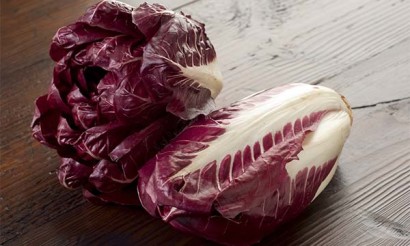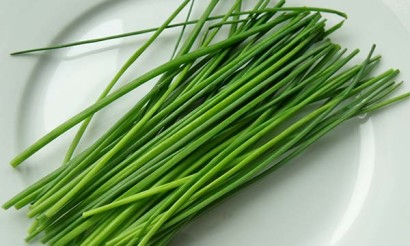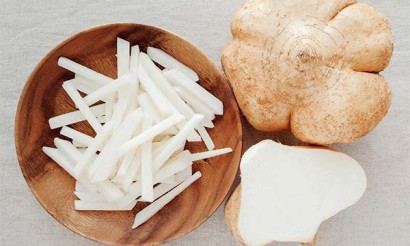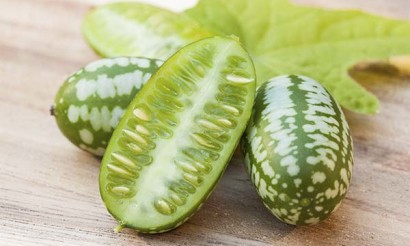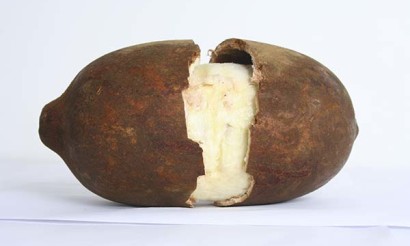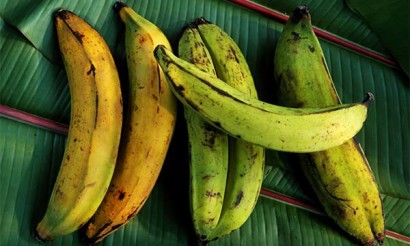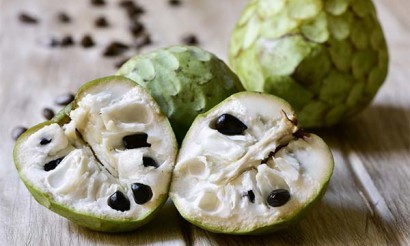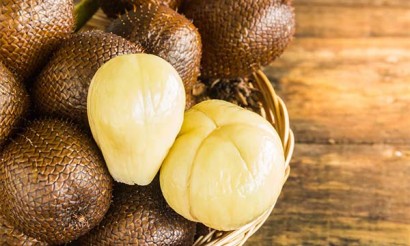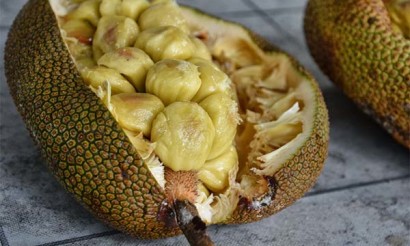Chompu: what is this fruit and why is it useful?
Tourists have fallen in love vacationing in Asia, not only for the beautiful landscapes, bustling ocean and snow-white beaches, but also for an unusual amount of unknown fruit. This includes chompu. It has a host of other names, including Malabar plum, pink apple, and pink not because of the color, but because of the flavor, reminiscent of rosewater.
- What this fruit is.
- How it looks
- Where does it grow?
- What is the usefulness of the chompu fruit
- What harm can come from
- How to eat chompa fruit correctly
- What can be made from chompu
- Folk Medicine Applications
- Cosmetic Applications
- How to grow chompu
- How to store the fruit
- How to transport
- How to choose
Chompu has a lot of health benefits and almost no contraindications. It is even consumed as a main dish, and Malaysian women have not neglected the chance to add this miracle fruit to their face, body and hair care kit.
What is this fruit.
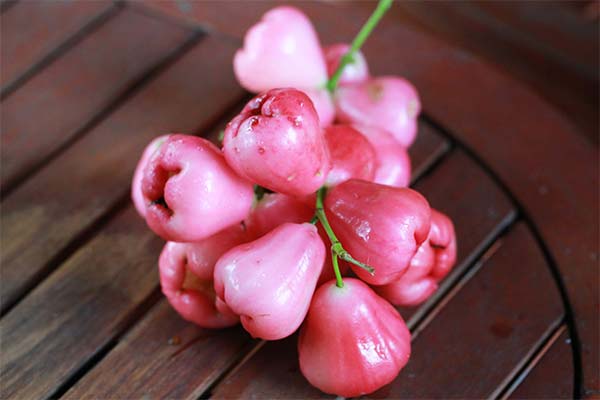
Chompu is a unique fruit of the myrtle family. It is tasty, yet not at all nutritious or caloric. The energy value of the fruit is only 25 kcal. For 100 grams of fruit there are 0.3 grams of fat, 0.6 grams of protein and 5.7 grams of carbohydrates. This is why they are unlikely to be full, but you certainly won't be thirsty. And all because it consists of 93% water, its friable, but juicy flesh, perfectly copes with thirst. Inhabitants of hot Asian countries cannot do without it at all on a sweltering summer day.
Interestingly, it is because of the lack of a distinctive taste, though rather unconventional, chompu is not too adored by tourists. Nevertheless, the locals can not imagine life without the fruit.
How it looks
The chompu plant can reach 12 meters, but more commonly it is an 8-10 meter tree with large oval bright green leaves, a spreading crown, and a thin trunk. Not only do the trees have unique fruits, but they also beautify and green areas.
The rose tree bears fruit mainly from mid-spring to mid-summer. But in Thailand, the fruit ripens twice a year: in winter and spring. The fruits, which grow in clusters, are shiny and resemble bell peppers or pears. Their color can vary from pale green to burgundy. By the way, they can also differ in appearance, so, the light fruits are more rounded and small, while the red and maroon fruits look more like a bell. They do not have a definite taste and smell, but resemble a slightly sweet pink water. The flesh can range in color from white to light yellow. And the whiter the flesh, the more pronounced the flavor will be, and the chompu will not be sour.
Where it grows
The name Malabar plum is not accidental, but came from the fact that the first fruits were found on the coast of the island of Hindustan - the Malabar coast.
Most often found in Asian countries: Thailand, Indonesia, Malaysia, India, Vietnam. And it is in these countries that the fruit remains the most popular and widely consumed to this day.
In the United States, chompa was discovered in the 18th century, when it was exported by American mariners from Sri Lanka. But despite all the efforts, it was difficult to popularize the fruit in America, the tree took root and continues to bear fruit only in a few states. The chompu tree is very fastidious and needs a special climate and soil. And if it can get used to the climate conditions, and sometimes even withstand a light frost, but not to the soil, which is why the tree takes root, but does not fructify. Attempts to cultivate chompa in Africa and Australia ended with success only in the XIX century.
How is the fruit of chompu useful?
Due to its rich mineral and vitamin complex, the pink apple has a number of useful properties.

The inhabitants of Asia most often use it as a thirst-quenching and diuretic. And because it contains no sugar, it can be eaten by people who are diabetic and overweight. In addition, chompu is very useful because of its composition. It is rich in vitamin C, which in one fruit contains a quarter of the daily rate. It also contains a large number of B vitamins, which are responsible for the proper digestion of fats, proteins and carbohydrates, support the reproductive system and the gastrointestinal tract. Vitamin A, which keeps the hair and skin in good condition, is also present in the fruit. It also contains minerals such as potassium and calcium.
Interestingly, not only the fruit itself is useful, but also the leaves and even the bark of the tree. For example, chompu bark contains tannin, which is antibacterial and styptic. Chompu is often used for diarrhea as an intestinal fortifier and antimicrobial. Malabar plum pulp is used for colds. And from the leaves prepare essential oil, which combats runny nose, allergies, and also helps with insect bites.
What harm it can do
Chompu is one of the few fruits that has almost no contraindications. The only thing that can be allergic is an intolerance to certain components or vitamin C.
You should also be careful with the seeds because they are poisonous and can be poisoned. If you know that you have an allergy or have previously been observed reactions to cherry seeds or apple seeds, then no infusions and decoctions of the bark and leaves should not be used. And all because they have a fairly high content of hydrocyanic acid, which can lead to the development of anaphylactic shock, up to and including death.
Nevertheless, the pulp of the fruit can be tasted by everyone without any fear.
How to eat chompa fruit correctly
The pink apple in its raw form is eaten without peeling the skin. Depending on the variety and ripeness, there may be up to 6 seeds in the fruit, but often there are none at all. Therefore, the fruit can safely eat itself and give to children.
Chompa is best eaten chilled or cold. It is in this condition that the fruit is most juicy and crispy, and its unusual flavor becomes most expressive.
It is also common to see the flesh of the fruit sprinkled with lime or lemon juice, but then the fruit becomes more savory, but unfortunately, its special flavor is lost. But if you sprinkle the pink apple with salt, you can not only enjoy the unusual taste, but also help to restore and maintain the acid-alkaline balance.
It is worth refraining from eating chompu at night because of the strong diuretic effect.
What you can make with chompu
Because chompu has no distinct flavor or aroma, it goes with most foods. It can be added to vegetable and fruit salads and served as a side dish to meat. But pink apple is most often eaten raw or stewed with sugar, and made into syrups, jams, and other desserts.
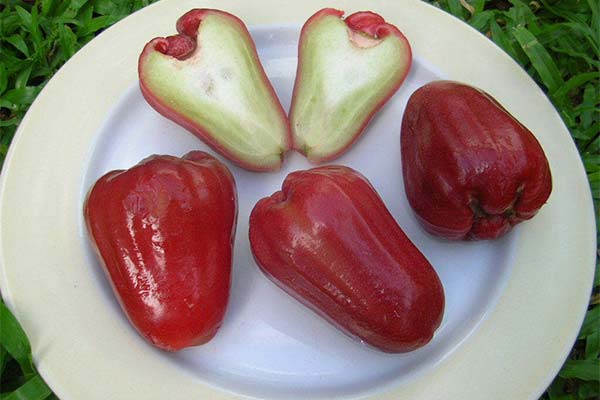
In Malaysia, the most popular recipe is chompu with rice and meat. The fruit is cut in half, pulverized, mixed with cooked rice, boiled meat, spices, and a special tomato sauce with garlic. After that they are baked in the oven for 15-20 minutes.
The fruit makes a delicious jam, jelly, marmalade, cooling drinks, it is used in baking and make a fruit stew or puree.
The Malabar plum drink is very popular. The fruit is cut and boiled without added sugar. This fruit water balances the body and a couple of sips are enough to quench one's thirst completely. Also this drink normalizes the gastrointestinal tract.
In some cities you can also find the wine from the fruit of chompu.
Traditional medicinal uses
- In Asia, chompu is widely known as a remedy for intestinal disorders and edema. And, if the fruit itself perfectly contributes to the removal of excess fluid from the body, and relieves edema, you should drink an infusion of the bark of the tree in case of diarrhea.
- The juice of the leaves of the pink apple is used as a lotion or tonic for problematic skin. Also, the leaves and pulp of the fruit are used as an antimicrobial. Decoctions are made from the fruit and taken for fever and colds.
- The essential oil from the leaves, which is a wound-healing and antimicrobial agent, is used by Malaysians for insect bites.
- In Thailand, the leaves of the chompu are sucked up for high blood pressure. And decoction from the bark helps with asthma and respiratory problems. It also has a beneficial effect on dry coughs and has an expectorant effect.
- The fruit pulp is useful for diabetes, it regulates the production of insulin in the blood. And in principle, because of the absence of sugars, the harm, with the existing disease, will not cause.
Cosmetic applications
- In its native land, chompu is most commonly found in the form of essential oils, which are made from the leaves. In the form of oil it is added to creams, shampoos and other cosmetic care products.
- The essence from the leaves is applied to the neck and wrists as a perfume, which also repels insects.
- The juice that is squeezed from the leaves is also used in its pure form as a face and body lotion. It fights wrinkles, tones the skin, evens out skin tone and protects from the scorching Asian sun.
- The grinded leaves are used as a mask for puffiness and black circles under the eyes.
- Rose apple leaf decoction is used as a hair rinse. It makes hair smooth, shiny, infuses it with moisture and minerals.
How to grow chompa
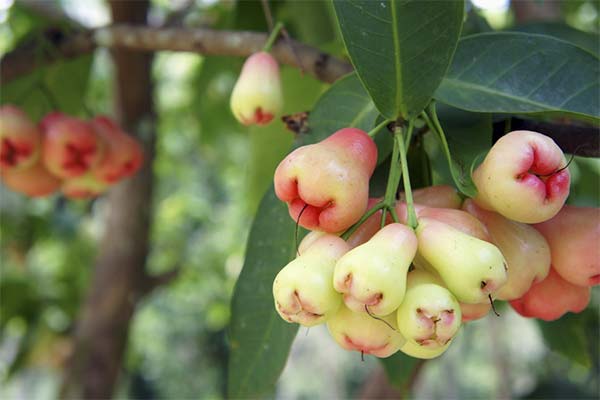
The Malabar plum is a rather fastidious plant. But interestingly enough, the tree can take root more easily at home than outside. You will need a large wide pot and 10-12 fresh fruit seeds, which should be planted in soil consisting of peat, sod and sand, in proportions of 1:1:1. Until the first sprouts, the pot should not be placed in direct sunlight. And better in a warm, but dark place. Water the plant as the soil dries. At the same time it is necessary to make sure that it does not dry out. Before watering you need to loosen the soil with a fork. Fertilize the plant as soon as the sprouts are at least 10-15 cm. For this purpose, any special fertilizer for myrtle, the only condition - they should only be liquid.
Chompu likes heat, but will easily survive +8°C. Do not put the plant in a draught.
How to store the fruit
Malabar plum fruits do not store for a long time, the maximum time for which they will not lose flavor and density is 2 days. After this time, the fruit will rot away irrespective of its storage conditions, with or without a closed container. The fruit spoils most quickly in bags and in the heat. That is, even with a great desire to bring from vacation a lot of useful fruit will not work, if you take it, then in minimal quantities.
Chompa can be frozen. To do this you need to wash the fruit, inspect it to make sure there are no scratches or soft spots, wipe it dry, and put it in the freezer in one piece, without cutting. When sliced, it will lose its pink notes, become soft and blacken. In this case, no useful properties will remain in it. But also in the freezer vitamins are preserved for only 1 month, no more. Defrosting the fruit should be done naturally, without resorting to tricks with warm water. The pulp will immediately change color, and the flavor will be gone.
How to transport
The Malabar plum is a very vulnerable fruit and also goes sour quickly. It can only be kept dense and whole for a long time on a tree. After it has been picked, the fruit begins to crumble and its flavor changes as well. Even though it is called an apple, you cannot transport it like apples. You should carry it only in hand luggage and ask the seller to pack it in a special container. At the slightest contact with a hard or sharp object, the fruit will disappear in a few hours, and there is no chance to bring it home.
How to choose
- In order to choose a fruit that will please the crisp flesh and pink taste you need to pay attention not only to the density of the fruit itself, but also how shiny the surface of the rind is. If it is matted in some places, it means that the fruit was picked a couple of days ago and it will not taste as good as the freshly picked one.
- Another criterion is the evenness of the color of the skin. It should be the same, without dark spots and seals.
- And, of course, the fruit should be firm, without mechanical damage and a pungent smell.
This is such an unusual pink apple with a lot of health benefits. And since it can be tasted only in the countries where it grows, if you have such an opportunity to try this treasure trove of vitamins, you should not miss it.
«Important: All information on this site is provided for informational purposes only. purposes only. Before using any recommendations, you should consult with a health care professional. specialist before using any of the recommendations. Neither the editors nor the authors shall be liable for any possible harm caused by materials."

